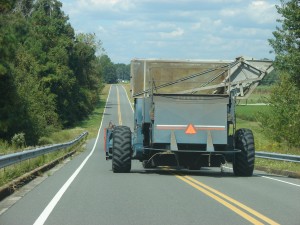 Many people have commented that there is more farm equipment on area roads at this time of year. That is because it is harvest time in North Florida. This is when area farmers bring out their harvesting equipment which is typically the largest equipment on the farm. It is also the time of year when every minute counts to make a difference in getting a crop harvested or having it damaged by poor weather because the farmer was too late to harvest. Therefore, farmers are often in more of a “hurry” than they may be at other times of the year.
Many people have commented that there is more farm equipment on area roads at this time of year. That is because it is harvest time in North Florida. This is when area farmers bring out their harvesting equipment which is typically the largest equipment on the farm. It is also the time of year when every minute counts to make a difference in getting a crop harvested or having it damaged by poor weather because the farmer was too late to harvest. Therefore, farmers are often in more of a “hurry” than they may be at other times of the year.
I want to take this opportunity to make the community aware of this increased farm “traffic” and offer some suggestions and perspective of what that farmer is dealing with, operating a machine on the roads that are obviously designed for the field. Riding behind or toward a piece of equipment it is easy to think that a machine can just “move over,” but in reality, tractor rollover is the leading cause of tractor related fatalities and pulling equipment on and off roadways is a large risk factor for rollover.
I read once that the time spent behind a slow moving tractor for a distance of two miles was the equivalent of sitting at two stoplights in town. We obviously wouldn’t put our lives and others at risks to skip sitting at two stoplights, so please be patient when sharing roadways with tractors and arrive alive. Your car or light truck would be a small match for an 80,000 pound machine if things get too close.
Here are a few thoughts that will keep you safe when sharing the road during this busy time of year:
- Be patient. Farmers have an important job to do and are not on the roadway to inconvenience motorist. They want to arrive to the field as quickly and as safely as possible.
- When you first see a tractor or equipment on the road, your first instinct should be to slow down. For the most part tractors and equipment top speed is about 20 miles per hour.
- Much of our harvesting equipment is 22 feet wide. County roads are 10 feet per lane, and state roads are 12 feet per lane. Do not attempt to pass unless there is ample shoulder, or the operator has pulled over to give clear access.
- Farms often caravan equipment in groups, if you attempt to pass there may be other farm equipment in line or a flag truck in the lead.
- Do not assume oncoming equipment will pull over if it is using part of or your entire lane. It is most likely the operator will not pull over onto the shoulder or into a ditch. Pulling onto unpaved surfaces without coming to a complete stop is extremely risky for the equipment/operator due to their instability and purpose built engineering. If there is not enough road for both vehicles to pass, pull over.
- If you pass equipment, watch for extra wide attachments or accessories. These are often wider than the tires or the body of the machine.
- Stay alert. Do not text, facebook, or tweet and drive. Your vehicle will close a 300 foot gap, the length of a football field, in five seconds when traveling at 55 MPH and encountering a slow moving vehicle from behind. Research shows that when texting, the eyes are off the road for 4.6 seconds of every 6 second period.
- When traveling on two lane roads, be aware that just around the next corner or over the hill, a slow moving tractor could be waiting. Do not use these roads to practice for the Daytona 500.
